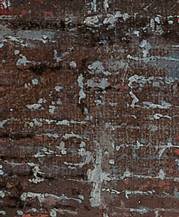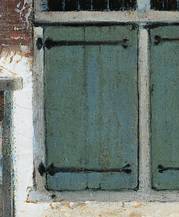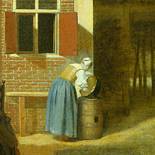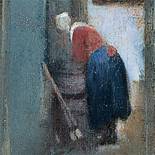![]()
 View of Houses in Delft, known as "The Little Street"
View of Houses in Delft, known as "The Little Street"
c. 1658; Oil on canvas, 54.3 x 44 cm; Rijksmuseum, Amsterdam
In a cobblestone street are two houses with a gate opening onto the passageway between them. A woman sits in an open doorway, busy sewing; two children are playing on the stoop. Soapy water is washing down a small runnel between the paving stones - probably the woman in the passageway has just scrubbed her part of the stoop. Vermeer has recorded this everyday scene with apparent casualness. Although world-famous, not much is known about Vermeer's Little Street. In fact the original location has never been identified, and indeed may never have existed. But more significant is the atmosphere of the picture. The women are diligently employed while the children are absorbed at play. The scene emanates tranquillity and security.
Vermeer has achieved a great deal with limited means. A detail from the bricks above the gateway illustrates how suggestive his method of painting is. In some places the canvas shows through the paint but together the touches of color combine to create the impression of solid brick. Elsewhere the paint has been thickly applied, as on the shutters in front of the windows and the white plastered portions of the wall. Here the surface of the paint appears flaked, like plaster, while on the shutters it is smooth as if painted on wood.
 Wall above the gate: dabs of paint
Wall above the gate: dabs of paint
 The chalk is almost tangibly flaked
The chalk is almost tangibly flaked
 Smoothly painted shutters
Smoothly painted shutters
Probably the water in the gutter runs out into a ditch or canal, in front of the picture. Without the diagonal of the gutter the picture would have less depth. And with the gutter Vermeer draws the viewer's attention to the woman in the passageway. Clearly, the artist found this through-view important; as an overpainting shows. Originally there was also a second woman in the gateway, but because her figure blocked the view through the passageway, Vermeer painted her out. Vermeer would have seen similar through-views by his colleague and townsman, Pieter de Hooch. However, only rarely did De Hooch employ this technique as successfully as Vermeer has here.
 Woman seated: X-ray photo
Woman seated: X-ray photo
 De Hooch: slightly less subtle
De Hooch: slightly less subtle
 De Hooch's woman, window and wall
De Hooch's woman, window and wall
In this picture the sky is cloudy and the colours are muted. Besides brown and red there are touches of blue in the sky, the garments of the woman who is furthest away, and the plant at the left. When first painted the ivy was greener, but the yellow pigment in the paint has faded. Nevertheless, the painting appears fresh, thanks to the white plasterwork. Against this, the figures stand out in pleasing contrast. At the left is Vermeer's signature - also on a white wall. The figures appear convincingly real, even though, like the bricks or the cobblestones, they are not rendered in detail.
 Scrubbing woman with a touch of blue
Scrubbing woman with a touch of blue
 Blue-green ivy; signature
Blue-green ivy; signature
 Woman sewing in doorway
Woman sewing in doorway
When Vermeer died he left no more than 34 paintings. These found their way into private collections and were 'forgotten'. In the nineteenth century Vermeer was rediscovered. His work soon became popular and prices for his paintings soared. The Little Street was in the collection of Professor Jan Six at the start of the twentieth century. Six wanted a million guilders (!) for the painting, but in the end he received just 625,000. It was bought by a wealthy industrialist who snatched it from under the noses of French buyers. In 1921 he presented it to the Rijksmuseum. The Little Street now hangs near the three other Vermeers in the museum: the Kitchen Maid, the Woman Reading a Letter and the Love Letter.
Credits: The Rijksmuseum, Amsterdam.